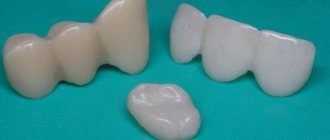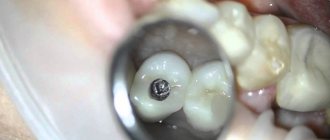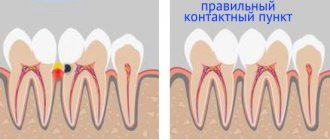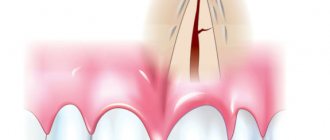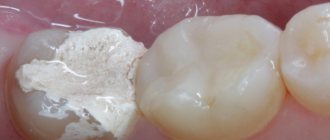Filling of baby teeth should be done in a timely manner to prevent tooth loss.
There is an opinion that baby teeth do not need to be treated, they should be removed immediately. But this is completely misleading. Early removal leads to jaw deformation and incorrect inclination of baby teeth. The permanent bone tissue that appears on the surface will lack a “supporting wall.” After removal, problems with bite formation may occur. And this, in turn, can cause more serious pathologies of the gastrointestinal tract.
But some parents firmly believe that even if, for example, caries is present, nothing bad will happen. When the baby tooth falls out, the problem will solve itself. It is not right. We must not forget that caries is caused by an infection that can migrate throughout the body. In childhood, especially when certain vaccinations are missing, this can cause meningitis, polio, sinusitis, chronic tonsillitis, tonsillitis, and bronchitis.
Filling at an early age will help the bite, speech, normal chewing function to form correctly, and maxillofacial deformities will not develop.
The most common dental problem in childhood is caries; it can occur as early as the first year of life. According to statistics, 13% of children under one year of age have caries. At the age of 6, 78% are already diagnosed with pathology of primary teeth.
Features of filling
Our dentists use a variety of treatment options, starting from a very young age. Doctors use treatment approaches that do not cause mental trauma to children.
Installing fillings on milk bone tissue is practically no different from filling adults.
What materials are used
- Amalgam.
- Glass ionomer cement.
- Composites (combined filling).
Advantages of breast filling
- Filled baby teeth look aesthetically pleasing and are visually indistinguishable from natural ones.
- After filling, baby teeth are reliably protected from pathogenic infection; it will not penetrate into the bone tissue.
- Thanks to modern filling materials, even large cavities of destruction can be restored.
Colored fillings
This modern method of breast bone tissue restoration was developed specifically for the treatment of children. The fear and tears of children in front of dentists are replaced by interest when doctors offer children to get such fillings. All kids love bright, beautiful fillings and teeth painted in all the colors of the rainbow. They can choose their own color.
In addition, funny fillings have one advantage - they release fluoride ions, which prevents the development of secondary caries in the future.
The advantages of colored material include:
- eight spectacular, brilliant and bright colors that will not leave any child indifferent;
- fillings are perfectly polished;
- prevention of caries;
- the material is strong, so you won’t need to worry before replacing baby teeth with permanent ones;
- anti-allergenic and safe for children.
What is a light seal
It is no secret that Soviet dentistry was on the sidelines of world progress in its field of medicine. Today things are much better. If we talk about private dentistry, then everything is pretty good here (relative to the recent past).
State clinics that provide dental services have also updated their material and technical base. Despite this, you can often find “dinosaur doctors” there who, “at their age,” no longer want to learn new modern techniques and treat the old-fashioned way.
And the system of state dental clinics itself has not gone far, if we talk about the standards of services provided. Well, for example, in our country, canals are still treated with arsenic (it’s poison, if anything), and light-curing filling remains a VIP service =).
Remember! In modern adult dentistry, arsenic is not used, and only light-cured fillings are used!
A light-curing filling or photopolymer filling is a plastic material, the hardening of which occurs under the influence of a special polymerization lamp.
Even the simplest light filling has a tremendous advantage over a conventional filling (chemical curing). Among the advantages are: better fit (read to the end why this is needed), resistance to abrasion, and the ability to accurately adjust the shape of the tooth being restored, as a result - turnkey work in one visit.
Important! The key to a good and durable filling is not only the material, but also the quality of the treatment performed!
Yes, you can put a filling made of the most expensive material, but treat the tooth in such a way that within a year the tooth will have to be removed (this is, of course, necessary to try, but it happens).
Filling or silver plating
Silver ions stop the growth and division of pathogenic microorganisms. This means that caries will not develop in the future. But silvering is prescribed only in the initial stages of the disease. When large areas are damaged, it is useless to silver a baby tooth; over time, it will still collapse. A puncture may occur, which certainly will not be pleasant for the baby.
Is it possible to do a filling without a drill?
Today, medicine has made great progress and dentistry is no exception. Our clinic has ultra-modern equipment that does not produce frightening noisy sounds. In addition, filling is currently performed chemically. Its essence is the application of a special gel-like substance, which, after 30 minutes of exposure, is removed along with the damaged tissues. Then filling material is applied to this place.
Anesthesia
In order not to traumatize the psyche of children, dentists use injections extremely rarely. Pain-relieving gels and sprays are mainly used. Injection anesthesia is used only in extreme cases.
Anesthetics are selected in each individual case and are used only when there are no contraindications.
Causes of caries
- artificial feeding;
- genetic predisposition;
- poor nutrition (lack of sufficient fluoride in the diet),
- injuries;
- defects, features of the anatomical structure of bone tissue;
- poor oral hygiene;
If the development of the disease is associated with inheritance or poor health, it is necessary to regularly show the child to the pediatric dentist.
And dentistry can be fun: bright colored fillings for the youngest patients
Colored fillings for children have become a real breakthrough in dentistry. Today, many modern dental clinics offer this type of filling. The popularity of such multi-colored fillings is quite understandable, because this is one of the few guaranteed ways to attract the attention of a child and relieve him of groundless fears about dental treatment. Often, this is the only opportunity to force a restless baby to sit in a chair and wait for the doctor to leave a bright spot on the tooth, which can then be shown to friends. Such cheerful multi-colored fillings for little patients will be discussed further in this article.
Recommendations and precautions
In the course of his work, the doctor must take into account the following factors, ignoring which can harm the patient’s health:
- The material does not tolerate the presence of eugenol, elements of clove oil contained in a number of cement masses. This can negatively affect the result and reduce the quality of polymerization of the composition.
- It is important to eliminate the risk of allergies. Twinkies are a component based on polymers with a reflective color effect.
This external result is not a product of metallic light reflection, but was achieved due to the presence of mica.It is classified as a substance that cannot dissolve. At the same time, mica maintains a level of toxicity below permissible limits; in rare cases, an allergic reaction may occur in a child.
Material requirements
Dental cements must meet a number of criteria. The main requirements include:
- biological compatibility;
- inertness, resistance to exposure to tissue fluids;
- maintaining plasticity, which is necessary for proper modeling of the filling during installation;
- coincidence of the expansion coefficient with the characteristics of the tooth tissues;
- high adhesion;
- rapid hardening when interacting with saliva;
- color stability, availability of a wide palette;
- no shrinkage of cement after it hardens.
In terms of its parameters, a high-quality filling must match the characteristics of the enamel. It must be resistant to loads, abrasion, and have a long service life.
Dental treatment under anesthesia
In most cases, treatment is carried out after the introduction of anesthesia, which is divided into two types - application with local application of medication and injection, which involves the administration of an injection. The second option is safer and more effective.
If a child has panic fear or is simply restless, anesthesia is used, but before using it, a number of diagnostic measures are prescribed:
- biochemical blood test;
- general blood and urine tests;
- blood to determine sugar levels;
- electrocardiography to assess the state of the heart.
You should not eat food 5–6 hours before anesthesia, and drink water and other liquids 4 hours before.
Sleep is induced very gradually using sevoflurane-based gas. If the child needs to be woken up, the doctor increases the amount of oxygen supplied, and this can be done at any time. After waking up, all reflex functions are fully restored within the first 15 minutes. As a rule, there are no complications.
What is the service life?
Most children's fillings are characterized by durability; they can last until the baby tooth falls out (taking into account proper and regular hygiene procedures). Standard service life is 2-3 years.
In many ways, the reliability of fixation and service life of the filling, as well as the prevention of secondary caries, depend on adhesive systems. For the treatment of primary molars and incisors, adhesive systems of 4-7 generations are most often used.
Contents and release form
The drug is available both in capsules and in special applicators.
The set of stuffable capsules is a set of 40 units of the product, each of which is packaged in an individual mini-container. The set contains eight color shades:
- green;
- orange;
- gold;
- silver;
- blue;
- pink;
- blackberry;
- citric.
The number of capsules of one shade, convenient and quite practical for transportation, storage and use, is 5 units of 0.25 g each.
The product, packaged in the form of applicators, has a dosage of 2 g, in one set there are 100 units of cannulas, this allows you to deliver the drug directly into the cavity as accurately as possible.
Preparation
Preliminary preparation for the upcoming filling of the cavity with a filling compound includes the following sequential actions of a specialist:
- cleaning the tooth with a special paste that does not contain fluoride compounds;
- isolation of the working area from adjacent units and the oral cavity;
- choosing a color scheme, as a rule, children actively and happily take part in this process;
- cavity preparation - here the technique of minimally invasive preparation is strictly followed, so that as many healthy, surrounding tissue fragments are preserved as possible;
- cleaning - carefully but thoroughly wash out all residues from the cavity with a stream of water, trying to completely eliminate its contact with blood and salivary fluid.
Excess moisture is removed with dry, warm air of targeted targeted action. A properly prepared area should be slightly damp; - protection of pulp tissue - this manipulation will be required only if the pulp is atypically close; in other clinical situations, padding is not required;
- adhesive - the procedure is performed sequentially and strictly layer by layer with an interval of 40 seconds. This time is quite enough for polymerization. For high-quality setting of the component, standard polymerization devices are used.
The final step is processing and polishing the surface, after which final fluoridation is performed along the edges of the filling, or the entire organ is coated with the product.
Pediatric dentistry in Perm SC “Apollonia”: fissure sealing
Fissures
- these are folds and depressions on the surface of the enamel. Each person has a different fissure pattern, but plaque tends to get stuck in the folds of tooth enamel.
Pediatric dentistry is rich in various prevention methods. The method of fissure sealing is especially important during the period of change from primary to permanent occlusion.
Microorganisms in the oral cavity, processing plaque, form acid that corrodes the tooth. This is how caries occurs. This can be avoided by sealing the fissures. It is very important to carry out such a procedure in the early stages after tooth eruption, since during this period the enamel is poorly mineralized and, therefore, more susceptible to caries. The sealant mechanically protects the tooth enamel and chemically strengthens the enamel structure by releasing fluoride.
Instructions for use
The composition is introduced into the cavity in layers. The thicker the filling, the more layers need to be applied. As they are applied, polymerization occurs. In this case, the maximum permissible coating thickness is no more than 2 mm.
Special caps, translucent matrix devices, and wedges with a high degree of light conductivity are used.
In this case, the end part of the apparatus should be extremely close to the surface of the working area, so that a good quality of adaptation of the mass to the hard tissues of the tooth can be achieved.
If the distance is more than 5 mm, then a decrease in the depth of the cavity is observed, which will negatively affect the polymerization process. And this, in turn, is fraught with insufficient marginal adherence, subsequent pigmentation and the development of pulpitis of bacterial origin.
The finished surface is processed only after removing the matrix. This is done with special discs, after which the working area is covered with a varnish that fixes the result.
What anesthesia is used?
Baby teeth, like molars, have nerves, so they can hurt. During treatment, different types of anesthesia are used (according to the depth of tissue damage). There are three types of anesthesia, including:
- applique. It is a spray or gel that reduces sensitivity only on the surface of the oral mucosa. Application anesthesia is harmless and completely safe for the child’s body. It is often resorted to before removing a moving molar. For the treatment of caries or pulpitis, topical anesthesia is not enough;
- infiltration The technique involves an injection that blocks the nerve endings of the desired area. The new generation of drugs act instantly; after 2-3 minutes the doctor begins to treat caries, pulpitis or remove a fixed molar. During manipulations, the child is not tormented by painful sensations;
- conductor. This is the most powerful type of pain relief. It affects the nerve branch of a large area. Conduction anesthesia is used in rare cases when infiltration anesthesia is not enough (for example, if it is necessary to treat several teeth at once).
In pediatric dentistry, products based on articaine hydrochloride are used as an anesthetic.
In pediatric dentistry, products based on articaine hydrochloride are used for local anesthesia. The active substance has pronounced analgesic properties, but is non-toxic.
It rarely causes an allergic reaction and remains in the body for a short time. It is allowed to be used by children over 4 years of age.
